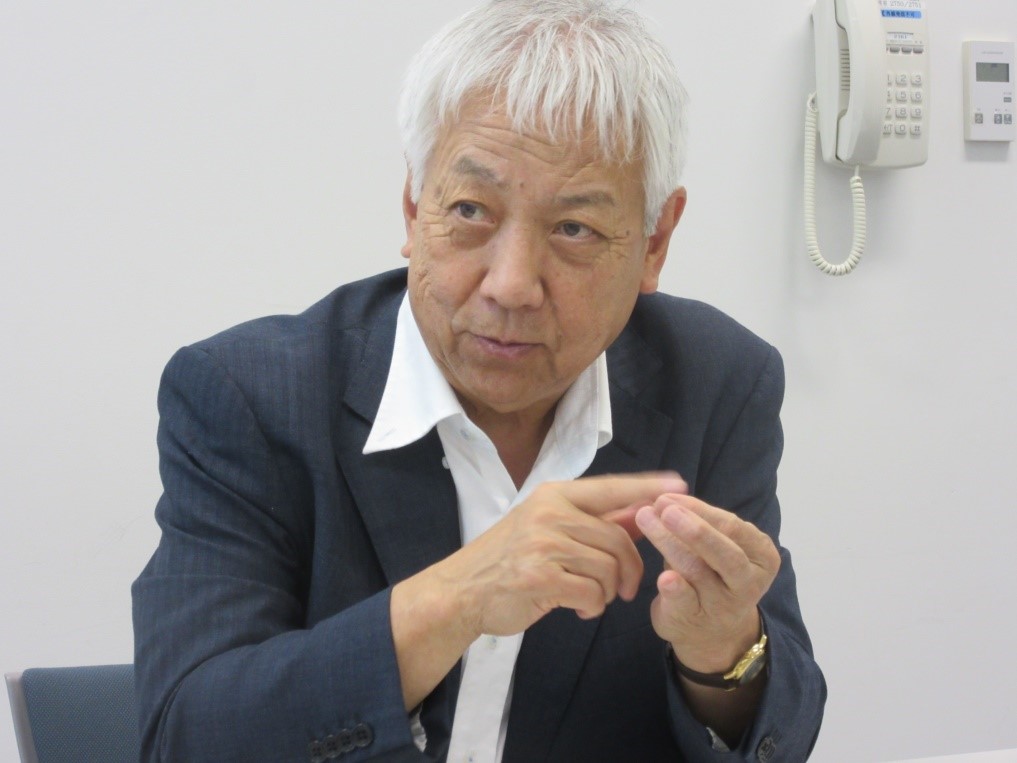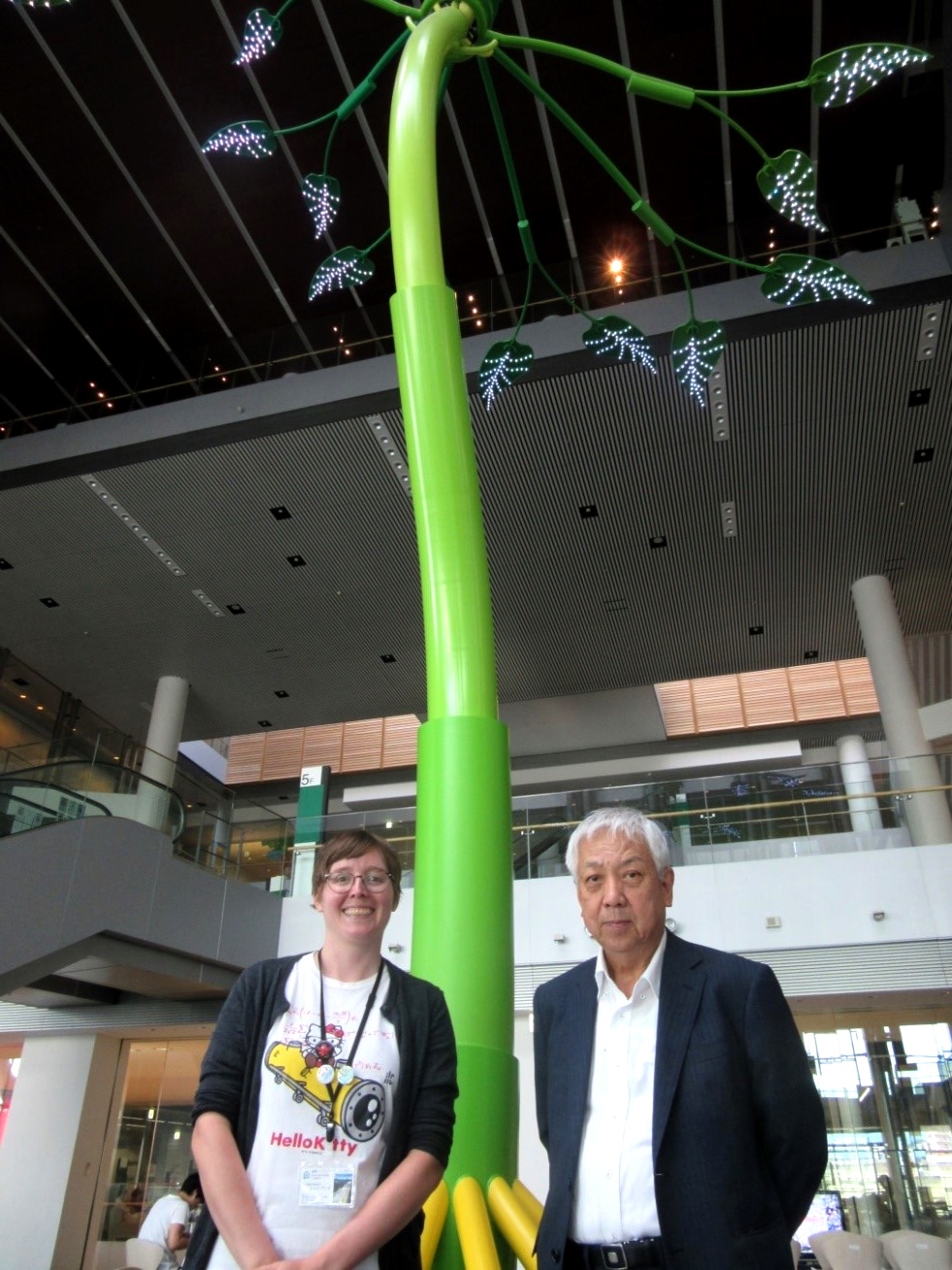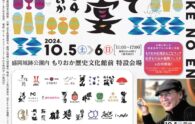Large scale particle accelerators eat a fair amount of electricity, and the ILC will be no exception, reaching 164 MW at peak power and consuming one billion kWh per year. While these needs pose no problem for Tohoku’s electricity supply, it’s still a lot. Most of this electricity will end up as waste heat under 100 degrees Celsius and released into the surrounding environment.
These conditions are an opportunity for those working on the Green ILC, the movement to make the ILC as sustainable as possible. I sat down with Dr. Masakazu Yoshioka, emeritus professor at KEK and guest professor at Iwate University and Tohoku University, to hear more. He’s been working to supply electricity to KEK projects like TRISTAN and B Factory (TRISTAN II) for about 20 years, all the while considering how to make these facilities more sustainable. Now, along with other researchers, groups like AAA, universities including Tohoku University, local government and businesses, Dr. Yoshioka is working for a future where the ILC not only uncovers new truths about our universe but acts as a resource for its community and a reference for society.
A Green ILC can be separated into components including:
• Designing an ILC that gets the maximum results out of electricity,
• Making the parts of the ILC efficient as possible,
• Using sustainable energy sources to power the ILC, and
• Storing and utilizing waste heat,
but in this article, we’ll focus on that last component.
Japan makes a lot of waste heat already—from factories, garbage facilities, unused heat from hot springs and geothermic energy plants and more— and with the exception of the occasional swimming pool, much of this is released into the air unused. This is a shame, because this heat could be put to use: in agricultural hothouses, to dry timber and woodchips, to heat buildings, and to raise marine products.
Enter HAS-Clay. HAS-Clay is a material originally developed by AIST (National Institute of Advanced Industrial Science and Technology) and that can store 580 MJ in 1 cubic meter. You need 13 cubic meters of natural gas to produce that much energy.

Dr. Yoshioka talks about the Green ILC
What Professor Yoshioka and others are proposing is a heat supply system encompassing the entire prefecture: use HAS-Clay to store waste heat from sources within Iwate including the ILC, and distribute that heat to facilities that can use it. Replacing the electricity consumed for heating in these facilities with waste heat would reduce CO2 production and costs for industries struggling to stay profitable like agriculture. It would also provide another potent answer to the question many local people will have: how does the ILC directly benefit my life?
The heat supply system still has some technical and logistical obstacles to overcome, but it’s developing actively and rapidly. Two papers on this subject—one focused on HAS-Clay and one on the proposed system itself—were just published in August for the Particle Accelerator Society of Japan’s annual meeting.

A picture with Dr. Yoshioka at Aiina (where LCWS 2016 was held)
The proposed heat supply system is part of a larger picture of an environmentally friendlier, innovative ILC. Dr. Yoshioka relates the ILC could run 100% from renewable electric energy, thanks to Tohoku’s generous renewable electric power capacity (19% of its total supply). Also expected to be part of the ILC’s legacy are using local wood for ILC campus buildings and a system of self-driving cars. As Professor Yoshioka pointed out, “We don’t need for the ILC to be finished to act.” The ILC is already changing Tohoku, right now.
Japanese
グリーンILC:排熱を地域の資源に
アンナ・トマス
大型加速器施設はかなりの電力を消費しますが、国際リニアコライダー(ILC)も例外ではありません。ILCのピーク電力は164MW, 年間では10億kWhを消費します。東北地域では問題なく供給できますが、それでもかなりの電力需要となります。このILCで利用された電力のほとんどは100°C以下の熱となり、周辺環境に排熱されることになります。
この事実が「グリーンILC」(ILCに環境にやさしい技術を取り入れること)に絶好の機会を与えてくれます。詳細を東北大学・岩手大学客員教授の吉岡正和先生に語っていただきました。吉岡先生は、約20年間、高エネルギー加速器研究機構 (KEK)のTRISTANやBファクトリー(TRISTAN II)の電力部門を担当し、大型加速器の省エネルギー化を検討してきました。現在、研究者、民間団体、東北大学などの大学、自治体、企業と一緒に、宇宙の謎を解明するだけではなく、国際リニアコライダーが地域貢献のモデルにもなるよう取り組んでいます。
(以下、吉岡先生へのインタビューから抜粋)
グリーンILCの取組について教えてください。
グリーンILCにはいくつかの要素があります:
• ILC設備の省エネと高効率化
• ILCの電力を再生可能エネルギーで供給すること
• ILCの 排熱を回収して活用すること
などですが今回は最後の「排熱」を話題にします。
日本では工場、ゴミ焼却施設 、温泉や地熱発電施設からたくさんの排熱が発生しています。一部はハウス栽培、木材や木質ペレットの乾燥、ビルの暖房などに活用できるにも関わらず、ほとんどの排熱が利用されないまま空気中に捨てられています。
そこで、HAS-Clay。HAS-Clay とは、国立研究開発法人産業技術総合研究所(AIST)によって開発された材料で1立方メートルに580MJの熱を蓄えます。これは天然ガスを13立方メートル燃焼させたときのエネルギーに相当します。
私も含めグリーンILCを進めている方々は、岩手県全体で排熱を供給するシステムを提案しています。ILCも含めて岩手県内各地からの排熱をHAS-Clayで蓄えて、利用できる施設に供給します。熱供給のために使用される電力の一部分を排熱に置き換えることで、CO2削減とコストダウンを図ることができ、さらにはその排熱を利用することで、農業などの産業にも貢献することができます。そして、この排熱の活用が、地域住民からよく出る質問―「ILCができると日常生活で何かいいことがあるのか?」に対する有力な答えにもなります。
この熱輸送システムには技術的・制度的にまだ課題が残ってい ますが、確実に進展しています。2017年8月に開催された日本加速器学会の年会でそれぞれHAS-Clay、輸送システムを中心にした二つの論文 が発表されました。
(インタビュアー所感)
この二つの論文で提案された排熱供給システムは革新的なILC施設全体の中の一部分にすぎません。吉岡先生によると東北地域の電力供給量のうち、再生可能エネルギーは19%を占めており、原理的にはILCを100%再生可能エネルギーによる電力で稼動させることが可能だそうです。またILCのキャンパスにおいて、車両の自動運転システムや地元産の木材の活用について検討を進めています。
「ILCがつくられるまで待っている必要はない。」吉岡先生はそうおっしゃいました。ILCはもう既に、東北を変えています。



